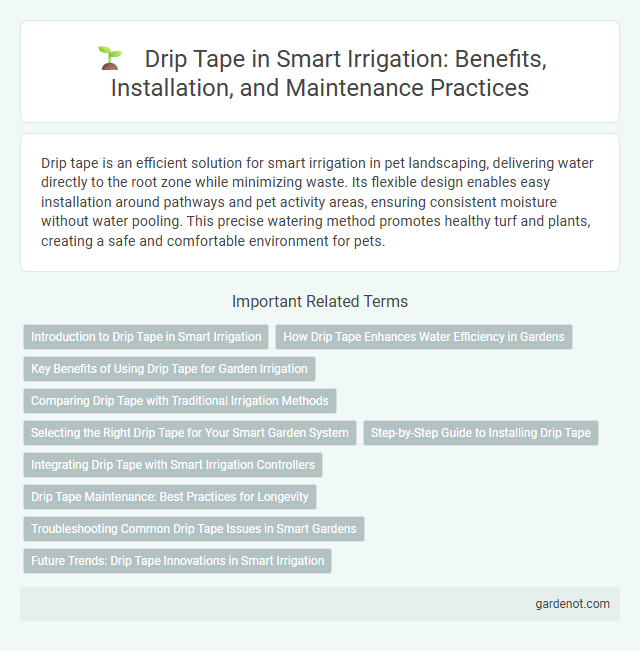Drip tape is an efficient solution for smart irrigation in pet landscaping, delivering water directly to the root zone while minimizing waste. Its flexible design enables easy installation around pathways and pet activity areas, ensuring consistent moisture without water pooling. This precise watering method promotes healthy turf and plants, creating a safe and comfortable environment for pets.
Introduction to Drip Tape in Smart Irrigation
Drip tape is a thin, flat tubing used in smart irrigation systems to deliver water directly to the root zones of plants, enhancing water efficiency and reducing runoff. Its uniform emitter spacing enables precise control of irrigation, making it ideal for row crops and gardens. Integration with automated controllers and soil moisture sensors optimizes water distribution based on crop needs and environmental conditions.
How Drip Tape Enhances Water Efficiency in Gardens
Drip tape enhances water efficiency in gardens by delivering precise amounts of water directly to plant roots, minimizing evaporation and runoff. Its low-pressure design ensures uniform water distribution, optimizing soil moisture levels and reducing waste. Gardeners benefit from improved plant health and significant water savings with this targeted irrigation method.
Key Benefits of Using Drip Tape for Garden Irrigation
Drip tape delivers water directly to the plant root zone, significantly reducing water wastage through evaporation and runoff. Its uniform emitters ensure consistent moisture levels, promoting healthier plant growth and higher yields. Easy installation and low maintenance make drip tape an efficient and cost-effective solution for garden irrigation.
Comparing Drip Tape with Traditional Irrigation Methods
Drip tape offers significantly higher water-use efficiency compared to traditional irrigation methods like flood or sprinkler systems by delivering water directly to the root zone, reducing evaporation and runoff. It enables precise water application, which conserves water resources while promoting healthier plant growth and higher crop yields. Traditional methods often result in uneven watering, increased water loss, and higher labor costs, making drip tape a more sustainable and cost-effective solution for modern agriculture.
Selecting the Right Drip Tape for Your Smart Garden System
Choosing the right drip tape for your smart garden system involves evaluating factors such as tape thickness, emitter spacing, and flow rate to ensure efficient water delivery. Opt for pressure-compensated drip tapes when working with uneven terrains to maintain uniform irrigation throughout the garden. Prioritize UV-resistant and durable materials to enhance the lifespan and performance of your smart irrigation setup.
Step-by-Step Guide to Installing Drip Tape
Begin installing drip tape by preparing the soil, ensuring it is free of debris and level for uniform water distribution. Lay the drip tape along planting rows, securing it with stakes or soil to prevent movement and connect it to a main water source using compatible fittings and pressure regulators. Flush the system before use to clear debris, then test for leaks and uniform emitters spacing, optimizing irrigation efficiency and water conservation.
Integrating Drip Tape with Smart Irrigation Controllers
Integrating drip tape with smart irrigation controllers enhances water-use efficiency by enabling precise, automated delivery based on real-time soil moisture data and weather conditions. Smart controllers can schedule irrigation cycles to optimize water distribution through drip tape systems, minimizing runoff and evaporation. This integration supports sustainable agriculture by reducing water waste and improving crop yield consistency.
Drip Tape Maintenance: Best Practices for Longevity
Drip tape maintenance requires regular inspection for clogs and leaks to ensure efficient water delivery and prevent plant stress. Flushing the system periodically removes sediment buildup, while careful handling and storage during the off-season preserve the tape's integrity and extend its lifespan. Using filtered water and avoiding exposure to direct sunlight when not in use also contribute significantly to drip tape longevity in smart irrigation systems.
Troubleshooting Common Drip Tape Issues in Smart Gardens
Clogged emitters in drip tape systems often result from mineral buildup or debris, requiring regular flushing and filter maintenance to restore optimal water flow. Leaks or tears in the tape reduce irrigation efficiency and demand prompt patching or replacement to prevent water wastage. Uneven water distribution can stem from incorrect pressure settings or damaged emitters, making pressure regulation and periodic system inspections essential in smart garden irrigation.
Future Trends: Drip Tape Innovations in Smart Irrigation
Drip tape technology is evolving with advancements in sensor integration and automated flow control to enhance water efficiency in smart irrigation systems. Emerging materials with increased durability and clog resistance contribute to longer-lasting drip tapes, reducing maintenance costs for farmers. The incorporation of AI-driven analytics enables precise water delivery tailored to specific crop needs, promoting sustainable agriculture and resource conservation.
Drip tape Infographic

 gardenot.com
gardenot.com